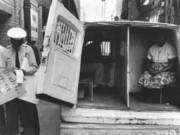This photo, Arrested Demonstrators, Birmingham, Alabama, was taken by Bruce Davidson in May 1963 and is part of the exhibition, Road to Freedom: Photographs of the Civil Rights Movement, 1956-1968, at the High Museum in Atlanta. We caught it this weekend, right before the show closes today.
The exhibition is a presentation of the work of many photographers, journalists and artist types alike, who put themselves on the scene at these pivotal events in our history. And that is what the prints reveal. The physical and moral courage of the people in the photographs is heartbreaking. Elizabeth Eckford, a fifteen year-old girl braving the segregationist savagery of Little Rock, epitomizes the grace that turned a gigantic page. The humanity on the faces of those who were able to withstand being beaten, sprayed, bitten, shot at – plus those who weren’t – is a stunning portrait of the history we are still living. What we cannot feel we will not be able to endure, and just as we are made stronger by their courage, so we live in the long shadow cast by their strength to act. That should be the real and living legacy of the era.
The show was punctuated by several different series of images where the photographer was able to capture a brief chronology of an unfolding drama. One series showed the events at the Edmund Pettus Bridge, where the local sheriff gave protesters a two-minute warning to vacate the bridge. Before the two minutes were even up, their assault began, an assault that resulted in John Lewis and Amelia Boynton being beaten unconscious. The leaders of the SCLC and the SNCC, in tandem with the journalists and photographers, learned how to use the actions of their southern antagonists against them. It was in many ways the powerless leveraging the conscience of a nation to achieve their goals. The images and stories shocked and embarrassed the country and focused great attention on the injustice of an unequal society.
This savvy to use the media seems at first incongruent to the bravery and heroism of the people who marched valiantly, who were assaulted with hoses, dogs and clubs, who bled with dignity and who buried loved ones for a cause greater than any of them individually. But rather than being out of place, it was one tool among many employed to effect great and lasting change. Their righteous goals empowered the use of all means of resistance plus a few that perhaps did not up until that time and may no longer exist. They were on the right side of history, and when you’ve got justice on your side, who knows to what you might be availed?

